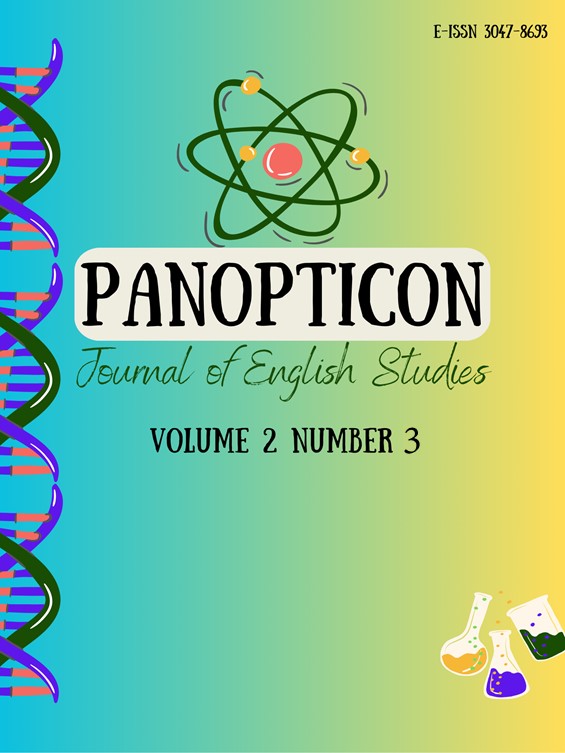Turn Taking Strategies in Hot Ones Show with Zayn Malik
Keywords:
Conversation analysis, Talk show, Turn takingAbstract
This study examines a conversation by analyzing the dynamics of turn-taking within it. The focus of the study is on a talk show from the Hot Ones program, featuring guest star Zayn Malik, posted on the YouTube channel. A qualitative approach is used to explore how the host and guests manage turn-taking to facilitate effective communication. The theoretical framework of Sacks et al. (1974) serves as the foundation for this study. The findings reveal the following turn-taking strategies: starting up (17), holding the floor (22), interrupting (12), overlapping (1), yielding the floor (2), and taking over (1). The analysis of turn-taking, particularly the prevalence of holding the floor, highlights key conversational strategies in talk shows. Through detailed examination of the video podcast data, new insights into the structure and dynamics of conversation, including various turn-taking strategies, are uncovered.
References
Adedoyin, O. B. (2020). Qualitative research methods. Research Gate.
Coulthard, M., & Johnson, A. (2007). An introduction to forensic linguistics language in evidence. Routledge.
Duncan, S. (1972). Some signals and rules for taking speaking turns in conversations. Journal of Personality and Social Psychology, 23(2), 283.
Handika, N., Misrohmawati, E. R. R., & Ro'is, S. (2022). Conversation analysis in The Man Who Knew Infinity movie. SALIENCE: English Language, Literature, and Education, 2(1).
Heritage, J. (2001). Goffman, Garfinkel and conversation analysis. In M. Wetherell, S. Taylor, & S. J. Yates (Eds.), Discourse theory and practice: A reader. Sage Publications.
Ismaliyah, N. (2015). Conversation analysis of turn taking mechanism in Piers Morgan Tonight talk show.
Jefferson, G. (2004). Glossary of transcript symbols with an introduction. In G. H. Lerner (Ed.), Conversation analysis: Studies from the first generation (pp. 13-31). John Benjamins.
Langerfeld, C., & Andersen, G. (2023). The dynamics of turn-taking in meetings of the Federal Open Market Committee. Fachsprache: International Journal of Specialized Communication, 45.
Liddicoat, A. J. (2021). An introduction to conversation analysis. Bloomsbury Publishing.
Munalim, L. O., Genuino, C. F., & Tuttle, B. E. (2022). Turn-taking model for Filipinos' high-context communication style from no-answered and non-answered questions in faculty meetings. 3L: Southeast Asian Journal of English Language Studies, 28(1).
Parsadanova, T. N. (2021). Discourse on television talk shows: Genre or format. TEXTS, 17(3), 42-46.
Pomerantz, A. (1984). Agreeing and disagreeing with assessments: Some features of preferred/dispreferred turn shaped.
Rahayu, E. S., Pratama, H., & Astuti, P. (2023). Evaluating power and status in turn-taking mechanism in Insight with Desi Anwar talk show. English Education Journal, 13(1), 20-28.
Sacks, H., Schegloff, E. A., & Jefferson, G. (1974). A simplest systematics for the organization of turn-taking for conversation. Language, 50(4), 696-735.
Schegloff, E. A. (1987). Some sources of misunderstanding in talk-in-interaction.
Schegloff, E. A. (2007). Sequence organization in interaction: A primer in conversation analysis (Vol. 1). Cambridge University Press.
Shi, B. (2023). Literature review of turn-taking. Journal of Linguistics and Communication Studies, 2(1), 22-30.
Skantze, G. (2021). Turn-taking in conversational systems and human-robot interaction: A review. Computer Speech & Language, 67, 101178.
Tsuraya, A. S. (2020, October). Kinds of turn-taking and the functions of overlaps in conversations. In Proceedings of the 2nd International Conference on English Language Education (ICONELE) 2020.
Vranjes, J., & Bot, H. (2021). A multimodal analysis of turn-taking in interpreter-mediated psychotherapy. Translation & Interpreting: The International Journal of Translation and Interpreting Research, 13(1), 101-117.
Downloads
Published
How to Cite
Issue
Section
License
Copyright (c) 2024 PANOPTICON: Journal of English Studies

This work is licensed under a Creative Commons Attribution 4.0 International License.


